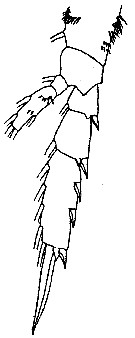|
|
 |
|
Calanoida ( Order ) |
|
|
|
Spinocalanoidea ( Superfamily ) |
|
|
|
Spinocalanidae ( Family ) |
|
|
|
Monacilla ( Genus ) |
|
|
| |
Monacilla gracilis (Wolfenden, 1911) (F) | |
| | | | | | | Syn.: | Oxycalanus gracilis Wolfenden, 1911 (p.221, Descr.F, figs.F) | | | | Ref.: | | | Tanaka, 1953 (p.130); 1956 c (p.398, figs.F); Vervoort, 1963 b (p.120, 121, Rem.); Damkaer, 1975 (p.66, Rem.); Brodsky & al., 1983 (p.330, figs.F); Bradford-Grieve & al., 1999 (p.878, 914, figs.F) |  issued from : Brodsky K.A., Vyshkvartseva N.V., Kos M.S. & Markhaseva E.L. in Opred. Faune SSSR, 1983, 135. [p.330, Fig.164]. Female (from Wolfenden, 1911); c: P4 = basipod 1 of P4.
|
 issued from : O. Tanaka in Publ. Seto Mar. Biol. Lab., 1956, V (3). [p.96, Fig.20]. Female: a, habitus (dorsal); b, last thoracic segment and genital somite (right lateral side); c, P4.
|
 issued from : R.N. Wolfenden in Die Marinen Copepoden der Deutschen Südpolar-Expedition 1901-1903, 1911. [p.221, Fig.10]. As Oxycalanus gracilis. Female (from tropical Atlantic): P2.
| | | | | Compl. Ref.: | | | Hsiao & al., 2004 (p.326, tab.1); Dur & al., 2007 (p.197, Table IV); Fernandes, 2008 (p.465, Tabl.2); Hsiao S.H. & al., 2011 (p.475, Appendix I) | | | | NZ: | 3 + 1 doubtful | | |
|
Distribution map of Monacilla gracilis by geographical zones
|
| | | | | | | Loc: | | | off Ascension Is., off Cape Verde Is., China Seas (South China Sea, in W. Zhang & al., 2010), E Taiwan (Kuroshio Current), ? Japan (Sagami), ? Taiwan | | | | N: | 8 | | | | Lg.: | | | (10) F: 1,9-1,8; (55) F: 2,25; {F: 1,80-2,25} | | | | Rem.: | For Vervoort (1963 b, p.120) the specimen referred by Tanaka to M. gracilis (Wolfenden, 1911) has a symmetrical genital somite, with a moderately produced genital swelling without tubercle on the right side. There is a broad row of acicular spines on the posterior aspect of the coxa of P4 and spines reach slightly beyond the articulation of the coxa with the basis. Tanaka's identification of this specimen with Wolfenden's Oxycalanus gracilis must be mainly based on the development of the acicular spines on the coxa of P4; though in Wolfenden's specimens this row was distinctly narrower, they did reach the articulation between coxa and basis (Ll.25, fig.4). The description and figure (Pl.25, fig.12) of the genital somite in the Vervoort's opinion are not detailed enough to warrant such a conclusion. Vervoort does not attach much importance to the development of the acicular spines, the more so since specimens, intermediate in this respect between M. typica and M. gracilis, have been described by Tanaka (1956 c, p.398) as M. typica var. asymmetrica. Though it seems advisable, at least for the present, to separate specifically specimens with an assymmetrically developed genital somite from those with a symmetrical urosome, this position could be seriously criticized. | | | Last update : 04/01/2022 | |
|
|
 Any use of this site for a publication will be mentioned with the following reference : Any use of this site for a publication will be mentioned with the following reference :
Razouls C., Desreumaux N., Kouwenberg J. and de Bovée F., 2005-2025. - Biodiversity of Marine Planktonic Copepods (morphology, geographical distribution and biological data). Sorbonne University, CNRS. Available at http://copepodes.obs-banyuls.fr/en [Accessed August 17, 2025] © copyright 2005-2025 Sorbonne University, CNRS
|
|
 |
 |






